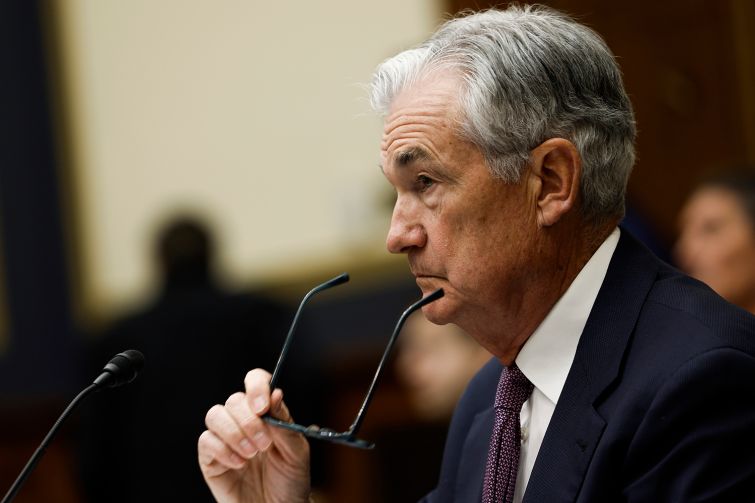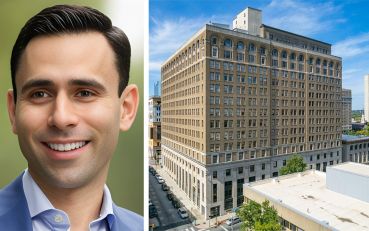Fed Leaves Interest Rates Unchanged But Uncertainty Persists for CRE Market
Central bank leaves the door open for another rate hike before year’s end to fight inflation.
By Andrew Coen September 20, 2023 2:13 pm
reprints
The Federal Reserve left short-term interest rates intact Wednesday, but indicated another hike could be on the horizon in late 2023.
For the second time in three meetings, the Fed opted for a pause in its 17-month period of increasing borrowing costs with the benchmark interest rate remaining unchanged at between 5.25 percent and 5.5 percent. The central bank indicated in its post-meeting economic projections summary that 12 of the 19 board members project an additional interest rate hike in one of its final two meetings of 2023.
“We are committed to achieving and sustaining a stance of monetary policy that is sufficiently restrictive to bring inflation down to our 2 percent goal over time,” Fed Chairman Jerome Powell said in his post-meeting press conference. “We are prepared to raise rates further if appropriate and we intend to hold policy at a restrictive level until we are confident that inflation is moving down considerably toward our objective.”
The Fed’s latest projections after Wednesday’s meeting forecast one more rate cut in 2023 and two in 2024. This would mark two fewer than what the central bank projected in June.
Prior to Wednesday, the Fed had raised interest rates in 11 of its last 12 meetings going back to March 2022 when the federal funds rate was at 0.25 percent to 0.5 percent. The central bank’s hawkish strategy of bringing interest rates to their highest level in 22 years has led to a number of banks moving commercial real estate lending activity to the sidelines.
“I don’t expect this interest rate hold will have much of an impact on the CRE market but it represents another step on the path to end tightening monetary policy,” said Ryan Severino, chief economist and head of U.S. Research at BGO. “Once the market believes the Fed is done increasing rates, it will feel more confident about price discovery and transactions getting done. We aren’t there yet, and inflation might hold a few surprises for us, but we are getting closer to the clarity the market craves.”
Ran Eliasaf, managing partner of real estate private equity firm Northwind Group, said he expects higher interest rates will be in place for the foreseeable future, and that CRE market participants will need to come to grips with this reality before transaction volume picks up again.
He noted that while rates are compared to the near-zero borrowing conditions that existed as recently as early 2022, they are still on the lower end of averages over the past 40 years.
“We’re in rehab from the low interest rate environment and we all need to get adjusted to the new reality,” Eliasaf said. “The market can absorb anything as long as it knows what’s coming, and stability is the most important thing to create a sound investment ecosystem.”
With many traditional bank and life insurance lenders stepping back over the past year, Eliasaf said business has been busier than ever originating multifamily loans in New York City and other gateway markets. Northwind has deployed tighter underwriting standards in the higher rate environment, with an average loan to value of 50 percent compared to a previous 65 percent LTV.
A prolonged period of elevated interest rates, which has also coincided with rising mortgage rates, has only increased demand for multifamily by placing more renters in the market, but production of new apartment units has slowed considerably as borrowing costs have gone up. The 44,000 of new multifamily properties completed in the U.S. in the first half of 2023 marks the lowest for any six-month period over the past six years, according to data from Fannie Mae (FNMA).
Doug Duncan, a senior vice president and chief economist at Fannie Mae, said major problems with multifamily loans are unlikely, since most existing properties are locked in with fixed-rate debt at lower levels or were able to avoid higher rates by refinancing prior to March 2022.
“The distribution of outstanding credits that has to be renewed doesn’t suggest you’ll see some big foreclosure problems or delinquency problems arising,” Duncan said. “In some cases there will be some firms that might have to bring in an angel investor to help them with the refinance, but we don’t actually expect a dramatic decline in loan quality.”
Fannie Mae is not projecting any rate cuts until the middle of 2024 with a belief that Fed Chairman Jerome Powell will try and avoid the mistake of former Fed Chair Paul Volcker in 1980, when rates came down too fast after a ramp-up period and triggered an 18-month recession. Duncan said Fannie Mare is forecasting a “mild recession” for early 2024 where unemployment rises to about 5 percent, but stressed there is also still a chance for a soft landing.
Eliasaf said full adjustment with valuations resulting from rising interest rates and changing consumer behaviors that have sprouted during the COVID-19 pandemic, like hybrid work, will start to occur in early 2024 as more loan maturities come due and sponsors are out of options for possible modifications. The lack of clarity with future interest rates and valuations coupled with wide gaps in the bid-ask spreads has slowed transaction volume over the past year, a trend Eliasaf does not see ending anytime soon.
“I think we’re still in the third or maybe fourth inning of this revaluation cycle, and the market hasn’t fully digested that higher interest rates, higher cap rates, higher cost of capital is here for a longer term, which will impact valuations tremendously,” Eliasaf said. “People have been kicking the can down the road, but the can is getting heavier and tougher to kick.”
Andrew Coen can be reached at acoen@commercialobserver.com


